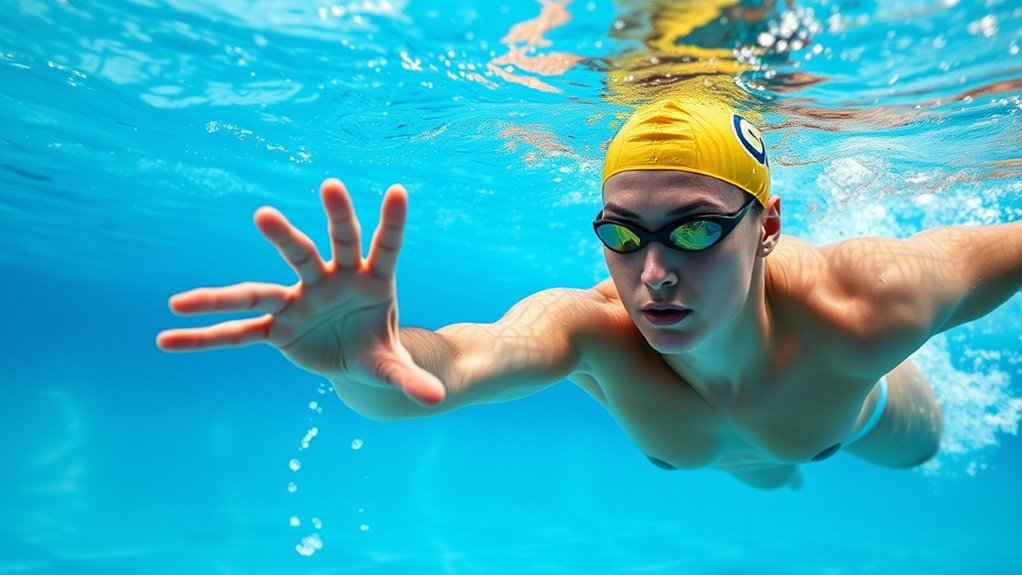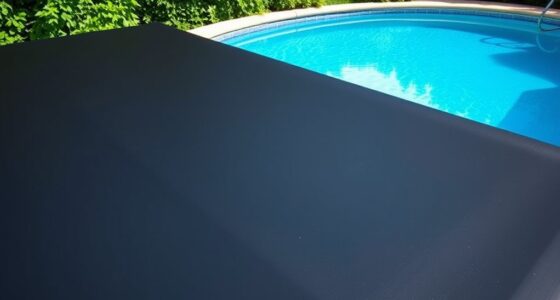To improve stationary swimming, focus on drills that refine your technique, breathing patterns, and kick consistency. Use breathing drills that emphasize rhythmic, bilateral breathing, exhaling fully underwater and maintaining a steady rhythm. Incorporate kickboard drills to develop a smooth, powerful kick from your hips while keeping your body aligned. Practice coordinating your breathing and kick for better efficiency. Keep practicing these targeted drills, and you’ll discover more ways to optimize your swimming performance.
Key Takeaways
- Use stationary drills like flutter kicks on a kickboard to improve kick technique and consistency.
- Practice bilateral breathing during stationary swims to develop rhythm and promote stroke balance.
- Focus on exhaling fully underwater and maintaining a steady breathing pattern to enhance efficiency.
- Incorporate drills that combine breathing with kick rhythm to build muscle memory and coordination.
- Maintain proper body alignment and controlled movements to maximize water management and reduce fatigue.

Improving your swim technique is essential for faster, more efficient swimming, and the best way to achieve this is through targeted drills. When focusing on stationary swimming, honing your breathing patterns and kick consistency becomes crucial. These elements directly influence your overall efficiency and stamina in the water, making drills that target them particularly effective.
Start by paying close attention to your breathing patterns. When you’re stationary, use drills that emphasize controlled, rhythmic breathing. For example, practice bilateral breathing, where you breathe alternately on both sides. This not only helps balance your stroke but also ensures you’re not over-relying on one side, reducing fatigue. As you breathe, focus on exhaling fully underwater so that you’re ready to inhale quickly and smoothly when your face turns to the side. Keeping a consistent rhythm in your breathing minimizes disruptions in your stroke flow and helps you conserve energy during longer swims. Incorporate drills like side breathing drills, where you hold a steady breathing pattern for an extended period, to develop muscle memory and comfort with your preferred rhythm.
Focus on rhythmic bilateral breathing and full exhalation to enhance stroke balance and conserve energy during stationary swims.
Kick consistency is equally important. A strong, steady kick propels you efficiently through the water and balances your stroke. While stationary, you can refine your kick by doing drills that isolate and strengthen this movement. Use a kickboard to focus solely on your kick, maintaining a consistent tempo and amplitude. Aim for a smooth, continuous motion that originates from your hips rather than your knees, which helps generate power without unnecessary fatigue. Pay close attention to your kick rate—find a pace that’s sustainable and keeps your body aligned in the water. If your kicks become irregular or lose rhythm, your entire stroke can suffer, so practicing with a metronome or counting kicks per minute can help maintain consistency. Additionally, drills focusing on body position can help improve overall streamline and reduce drag.
Both breathing patterns and kick consistency are interconnected; a steady kick makes breathing easier, and proper breathing supports sustained kicking. When doing stationary drills, stay mindful of maintaining these elements simultaneously. Focus on smooth, controlled movements, and avoid rushing through drills just to finish quickly. Instead, aim for deliberate, precise execution. Over time, these targeted drills will improve your ability to manage your breathing and kick rhythm naturally during actual swimming, translating to better efficiency, reduced fatigue, and faster times.
Frequently Asked Questions
Can Stationary Drills Improve My Overall Swimming Speed?
Yes, stationary drills can improve your overall swimming speed. They help you refine your technique by focusing on proper form and efficiency. By engaging the right muscles consistently, you build strength and develop better muscle memory. This targeted practice allows you to swim more efficiently and faster in the water. Incorporate stationary drills into your routine regularly to see noticeable improvements in your technique and speed over time.
How Often Should I Incorporate Stationary Drills Into My Training?
You should incorporate stationary drills into your training 2-3 times a week. Focus on maintaining a steady breathing rhythm and stroke consistency during these sessions. These drills help reinforce proper technique, improve your breathing efficiency, and build muscle memory. By regularly practicing, you’ll develop better control and form, which translate to increased speed and endurance in actual swimming. Consistency is key for measurable progress.
Are Stationary Drills Suitable for Beginner Swimmers?
Think of stationary drills like training wheels—they’re perfect for beginners. You’ll improve your breathing exercises and arm positioning without the challenge of moving forward. I once coached a new swimmer who quickly gained confidence practicing these drills, much like learning to ride a bike with stabilizers. Stationary drills help you build foundational skills safely, making them highly suitable for beginners to develop proper technique before progressing to full strokes.
What Equipment Is Necessary for Effective Stationary Swim Drills?
You’ll need basic swim gear like goggles and a swim cap to stay comfortable and focused during stationary drills. Resistance tools, such as hand paddles or pull buoys, are essential for adding resistance and building strength. These tools help you improve technique and endurance without moving through the water, making your practice more efficient. Make sure your equipment is well-maintained for best results and safety during your stationary swim sessions.
How Do Stationary Drills Help With Breathing Techniques?
Imagine opening a new level of confidence in the water. Stationary drills sharpen your breathing control, helping you stay calm and steady with each breath. They also boost stroke efficiency by making you more mindful of your breathing patterns. As you practice, you’ll find it easier to manage your breath during races, leading to smoother, more powerful strokes. This focused training transforms your swim, making every breath count.
Conclusion
By incorporating these stationary swim drills into your routine, you gently nurture your skills and build confidence beneath the surface. Remember, progress often comes in quiet moments of practice, not grand leaps. Embrace each small refinement as a step toward smoother, more effortless strokes. With patience and dedication, you’ll find yourself gliding through the water with a grace that’s only grown through gentle persistence. Trust in the process, and let each stroke carry you closer to your swimming aspirations.









